Apart from the specially built 'P' race
cars all the cars used the same basic layout with a longitudinal V12 at
the front driving the rear wheels through the rear mounted combined transmission and differential. The suspension was independent with
double wishbones and coil springs all round, joined by four disc brakes
to stop the car.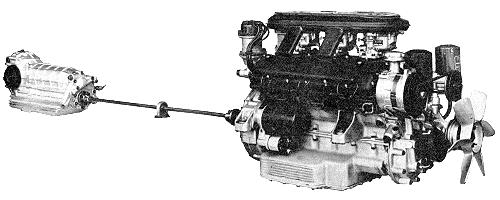 The 275 followed on from the 250, with
a few major differences. It was built from 1964 until 1968 in various versions
as detailed below.
The 275 followed on from the 250, with
a few major differences. It was built from 1964 until 1968 in various versions
as detailed below.
The biggest changes were
the independent rear suspension (for the first time on a Ferrari road car)
using double wishbones and the rear transaxle housing the complete transmission
(5-speed gearbox) and final drive. These two changes made the chassis considerable
more capable, and the overall effect was aided by the new 3286cc (77x58.8mm)
V12 which produced 280bhp with the help of three twin carburettors.
The clutch remained attached to the rear
of the engine from which there extended a solid propshaft. Later this was
replaced by a more robust torque tube. Braking was by discs all round.
The wheelbase was 2400mm and the car weighed 1100kg when empty.
In 1965 the design was slightly modified, the most noticeable difference being the extension of the
nose section. For this reason the later cars being known as the 'long-nose' variants. The modifications were aimed at reducing
front-end lift at high speed and included a revised grille and bumpers mounted higher up. Less visible differences included a larger boot,
revised fuel tanks and a slightly modified prop-shaft.
With development of the GTB/4 underway a second series of 275GTB's was built during the summer of 1966. These cars were the same as the series I
except for the use of a dry sump system and the installation of six Weber 40DCN carburettors, both features of the GTB/4.
Production continued until it was replaced
by the 275GTB/4 in 1966. Production figures were about 240 of the original
car, 205 'long-nose' versions and 12 series II cars.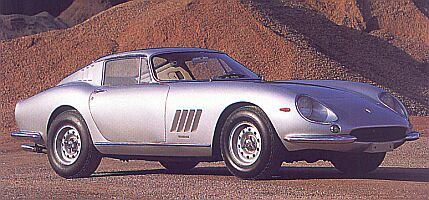 The
replacement for the greatly successful 250 GT, the 275 GTB was released
at Paris in 1964. Featuring numerous design cues from its predecessors,
mechanically it was a significant step forward. The body design was (as always!) by Pininfarina
and borrowed heavily from the classic 250GTO as well as other members of the 250 family.
The
replacement for the greatly successful 250 GT, the 275 GTB was released
at Paris in 1964. Featuring numerous design cues from its predecessors,
mechanically it was a significant step forward. The body design was (as always!) by Pininfarina
and borrowed heavily from the classic 250GTO as well as other members of the 250 family.
Around 200 examples were built in the two years folowing its launch.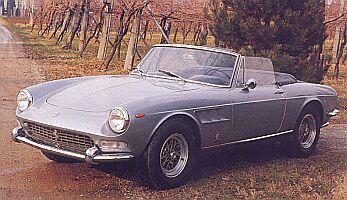 Alongside
the 275GTB at the Paris Motorshow of 1964, Ferrari unveiled the 275GTS
Spider. Mechanically identical to the coupe car it featued a completely
different body, again by Pininfarina. Designed to replace the 250 California
it had a much less sporting image than its coupe brother, being more of
a classic roofless GT car.
Alongside
the 275GTB at the Paris Motorshow of 1964, Ferrari unveiled the 275GTS
Spider. Mechanically identical to the coupe car it featued a completely
different body, again by Pininfarina. Designed to replace the 250 California
it had a much less sporting image than its coupe brother, being more of
a classic roofless GT car.
Due to the lack of a 275GTB Spider (the 275 GTS had a completely different design), Chinetti, the boss of NART, requested a handful of spider
versions to be built, a job carried out by Scagliett. Some were made by cutting the roof off the
coupé, whilst some were built as spiders. A total of ten chassis were so completed, the final result being known as the '275 GTB Spider Nart'.
Around 320 examples of the 275GTB/4 were built before production ceased in early 1968.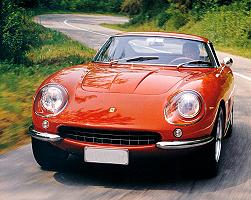 The Paris Motorshow in 1966 saw the arrival
of the new 275GTB/4, the designation referring to the most significant
technical change, namely the adoption of twin camshafts per cylinder bank
(ie 4 in total). The capacity remained the same whilst the power went up
to 300bhp @ 8,000rpm. As mentioned above, the three carburettors of the earlier cars were replaced by a bank of
six Weber 40DCN units. It was the first quad-cam road-going Ferrari built
and was easily recogniseable by the bulge in the bonnet compared to the earlier sohc cars. The new head did, however, provide some reliability
issues, and frequent servicing by a qualified mechanic was most necessary.
The Paris Motorshow in 1966 saw the arrival
of the new 275GTB/4, the designation referring to the most significant
technical change, namely the adoption of twin camshafts per cylinder bank
(ie 4 in total). The capacity remained the same whilst the power went up
to 300bhp @ 8,000rpm. As mentioned above, the three carburettors of the earlier cars were replaced by a bank of
six Weber 40DCN units. It was the first quad-cam road-going Ferrari built
and was easily recogniseable by the bulge in the bonnet compared to the earlier sohc cars. The new head did, however, provide some reliability
issues, and frequent servicing by a qualified mechanic was most necessary.
Pure racecars designed to beat Ford in the World Championship these were mid-engined open-topped cars. Apart from the 3.3-litre unit in the 275P there were also 4 and 4.4-litre versions.
In 1965 three examples of the new 275GTB were produced for motorsport, designed for endurance races. A significantly lightened aluminium body, six carburettors and dry-sump lunbrification improved the performance, aided by a power output of 320bhp. Various other competition modifications such as perspex windows and air vents for the brakes, were also applied.
See our picture gallery index for images from museums, motorshows and events.
There are also wallpapers/desktop backgrounds available to download.
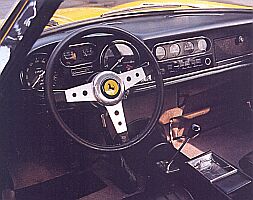
Use the buttons at the top to navigate further, or
Copyright © 2000 to 2011 CarsfromItaly